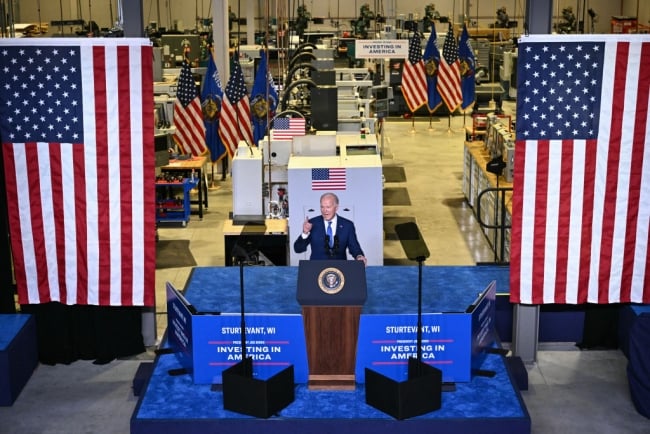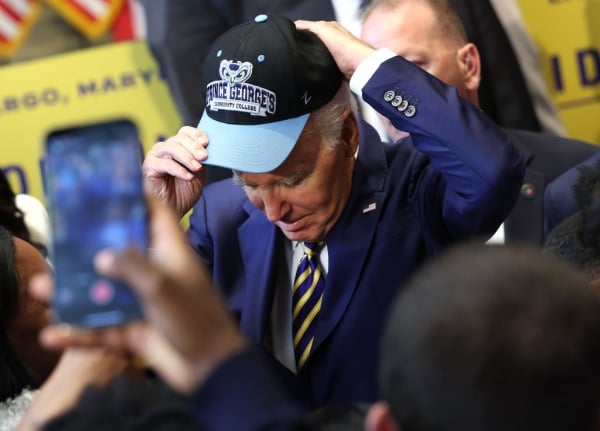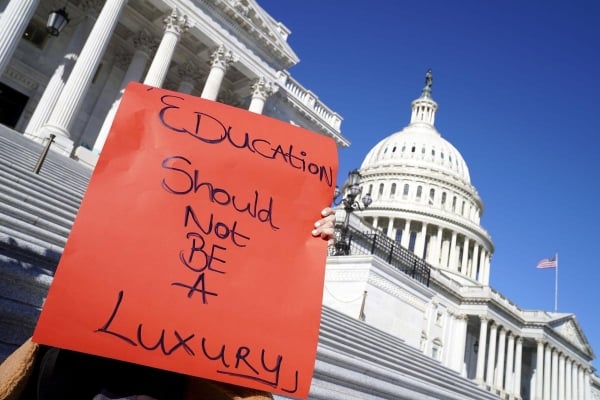You have /5 articles left.
Sign up for a free account or log in.

President Biden speaks at Gateway Technical College in Wisconsin in May. He has stopped at community colleges across the country to highlight their role in his plans to build the economy.
Mandel Ngan/AFP via Getty Images
President Biden entered the White House nearly four years ago with ambitious plans to make community college free—and check off a top item on progressives’ wish list for higher education.
The push for free college was part of Biden’s ambitious plan to reshape higher education and make college more affordable and accessible. Although Congress scuttled his plans, advocates and community college leaders say he’s raised the profile of the movement for free college, which has been gaining steam for the past decade, and laid a foundation for future legislative success while inspiring states to act on their own. The president, who decided last month to end his bid for re-election, will address the Democratic National Convention tonight.
“His high-profile and aggressive push for free community college elevated the issue to a much more prominent level,” said David Baime, senior vice president for government relations for the American Association of Community Colleges.
The push for free college would be expected to continue under a potential Harris-Walz administration, and would likely expand beyond eliminating tuition at community colleges. Vice President Kamala Harris hasn’t yet outlined her plans for higher education, but she’s backed legislation to make community college free and advocated for Biden’s plan. Her running mate, Minnesota governor Tim Walz, signed into law a free college program last year that covered the cost of tuition to any public college in the state for students from families who make less than $80,000 a year. Harris’s ability to make free college a reality nationally would depend on whether Democrats win the White House and control of the House and Senate, since the issue is overwhelmingly unpopular among Republicans in Congress.
Despite not getting free college done, Biden boosted the profile of community colleges and supported the institutions with increased federal funding and other resources. The president and First Lady Jill Biden, a community college professor herself, have been champions for the two-year institutions, visiting numerous community colleges and touting their benefits.
“Our schools accept everyone—regardless of age, race, income or family legacy,” Dr. Jill Biden said in April 2021 while visiting Sauk Valley Community College in Illinois. “And they don’t just improve individuals’ lives—they strengthen our country as a whole … Because without educated and trained workers, businesses can’t build. Innovation is held back, and our economy drags. We can’t afford to exclude so many from continuing their education just because they come from certain areas or income brackets.”
Nate Mackinnon, executive director of the Massachusetts Association of Community Colleges, said the Bidens’ support has altered the narrative about the institutions and the role they play in local communities.
“The fact that the first lady herself is not only a believer of community colleges but is one of us … has changed the entire federal and national conversation about the value community colleges play in every single state,” Mackinnon said. “It used to be that community colleges were known as America’s best-kept secret, and I think over the past four years in particular, the secret’s out.”
The Push Begins
Former president Barack Obama put free college on the national agenda in 2015 when he called at the State of the Union for eliminating tuition at community colleges for most students.
“By the end of this decade, two in three job openings will require some higher education—two in three,” Obama told Congress. “And yet, we still live in a country where too many bright, striving Americans are priced out of the education they need. It’s not fair to them, and it’s sure not smart for our future. That’s why I’m sending this Congress a bold new plan to lower the cost of community college—to zero.”
That plan, known as America’s College Promise, was modeled after the Tennessee Promise, which launched in the year before and covered the cost of community college for high school graduates in the state. Obama’s proposal didn’t move forward, but it did spur other states to follow Tennessee’s example. Since 2015, 33 states have started promise programs, though their structure and scope vary.
Federal Plans for Free College
College For All
- Lead sponsors: Vermont senator Bernie Sanders and Washington representative Pramila Jayapal; first introduced in 2015.
- What it would do: Make community college tuition-free for all students and also cover the cost of any public four-year college for students whose families earn less than $125,000 a year, double the Pell Grant’s maximum award, and increase funding for other higher education programs. This expansion would be paid for by a new tax on Wall Street transactions.
- Support: 75 co-sponsors in the House and Senate—the most support of the three legislative proposals. As a senator, Vice President Harris signed on to this legislation.
Debt-Free College Act
- Lead sponsors: Hawaii senator Brian Schatz and Wisconsin representative Mark Pocan; first introduced in 2018.
- What it would do: Incentivize states to ensure students don’t have to take on debt to pay for the full cost of attendance at public colleges and universities.
- Support: 18 co-sponsors in the House and Senate. (Harris also signed on to this bill as a senator.)
America’s College Promise Act
- Lead sponsors: Wisconsin senator Tammy Baldwin and New Mexico representative Teresa Leger Fernández; first introduced in 2015.
- What it would do: Fund partnerships with states to eliminate tuition and fees at community colleges for students and waive two years of tuition and fees for eligible students at tribal colleges and universities. Would also create a grant program for historically Black colleges and universities and minority-serving institutions to cover “a significant portion of tuition and fees” for low-income students in the first two years of attendance.
- Support: 20 co-sponsors in the House and Senate.
Biden helped roll out Obama’s free college plan as vice president and picked up on the issue again in 2020 as a candidate for the White House. On the campaign trail, Biden backed plans to make community college free as well as to cover the cost of tuition at public colleges and universities for all students whose families earn less than $125,000 a year.
Following Obama’s groundbreaking proposal, lawmakers in Congress developed three different options to make some form of free college a reality. But legislators didn’t see much movement on those proposals until Biden took office.
Biden immediately set out to make good on his campaign promise in 2021, proposing a $109 billion program for tuition-free community college in his first 100 days. The free college plan eventually morphed into a version of the America’s College Promise Act but was then cut from the social spending plan known as Build Back Better over concerns about the legislation’s price tag. Specifically, West Virginia senator Joe Manchin, a then-Democrat who has since changed his affiliation to Independent, balked at the cost along with Arizona senator Kyrsten Sinema, an Independent. Without those two votes, and with unified GOP opposition, the measure couldn’t move forward.
Despite the setback, Biden pledged to keep fighting. “I don’t know of any major change in American public policy that’s occurred by a single piece of legislation,” Biden said in October 2021. “I’m not going to give up on community colleges as long as I’m president.”
And he didn’t. Biden later proposed a $90 billion plan to make community college free in March 2023 along with a smaller $500 million grant program that would fund efforts at community colleges or in states to make certain programs tuition-free. Neither proposal moved forward, nor did his similar ask this year.
“We had a moment with Build Back Better,” said Wil Del Pilar, senior vice president at the Education Trust, a nonprofit organization that advocates for minority and low-income students. “There was momentum. Simply one person [Manchin] kept us from what could have been a pathway to free public college in this country. I’m hopeful that we’ll continue to make strides.”

Kevin Dietsch/Getty Images
States Pick Up the Baton
After free college was cut from Build Back Better, momentum on the issue shifted to states. Since Biden took office, 16 have started some form of free college programs—half of which began after the federal push fell apart, according to news reports. Those include Walz’s Minnesota along with Colorado, Massachusetts, New Hampshire and New Mexico.
Over all, at least 38 states now have scholarships on the books that cover some or all of the cost of community college, specific programs or four-year institutions, according to College Promise, a nonprofit that advocates for tuition-free postsecondary education and tracks state and local programs. During the Trump administration, 14 states launched promise programs.
“When the Biden administration’s free community college program failed to become a reality, it encouraged states to become more creative about their own programs,” Mackinnon said. “Free college programs jumped up across the country. It’s a direct reflection of that idea.”
This year, Massachusetts made community college free for anyone without a college degree, fulfilling a campaign promise by Governor Maura Healy. The program built on MassReconnect, launched in 2023, which eliminated tuition at community colleges for adults 25 or older without a college degree. MassReconnect boosted enrollment at the state’s two-year institutions by about 8 percent in its first semester.
“What we have found here is that the simple message of being free and keeping it simple has translated in a way that never has before,” said Mackinnon. “Complete the FAFSA and it’s free. Full stop. No gotchas. No ‘it depends.’ No 45 asterisks and footnotes. It’s just a simple message. It translates to people.”
Despite this “brush fire of adoption” at the state level, as Baime put it, free college proponents say federal action is still needed to help the state programs meet the needs of students. States are subsidizing free college from their own coffers, and federal investment would make the promise programs more sustainable.
“It makes sense as good public policy for the country as a whole to not have such variation based on available resources,” Mackinnon said.
A National Future
While the failure to get free college across the finish line in 2021 was a blow, advocates are optimistic that they can build on that progress the next time there’s an opportunity to do so.

Tom Harnisch, vice president of government relations at the State Higher Education Executive Officers Association, said the legislative process in 2021 was a sort of “test run” that exposed a free college plan to public scrutiny—feedback that will aid lawmakers in the next go-around.
Baime agrees. “The fact that it was approved by the committee in 2021 puts it on more solid legislative footing,” he said.
Advocates say the need for such a policy isn’t going away. College is still out of reach for many families, though postsecondary education and training are only going to be more essential in the future when it comes to securing a good-paying job—as Obama said when he touted free college back in 2015.
Read More
As the Democratic National Convention unfolds this week, check out our other recent stories on the candidates, the issues and the outgoing president:
Pilar, of Ed Trust, expects the urgency around free college to increase once this fall’s enrollment numbers come in. “I think there will be data to show that with current college enrollment rates, we’re not going to meet the workforce demands,” he said.
Peter Granville, a fellow at the progressive Century Foundation who has written about college promise programs, said that free college isn’t going away as an issue. It’ll be a logical focus for Democrats going forward, he said
The policy was one of two major initiatives in the Biden administration related to college affordability. The other? Forgiving student loans. Biden has so far proposed two different plans to forgive millions in federal student loans. The first was struck down by the Supreme Court, while the Education Department is working to finalize the other by the fall.
“The courts have made student debt release a real quagmire, so if you were the incoming Democratic president, what would you do next?” Granville said. “I think you try to tackle the underlying factors that make student debt such an issue … A plan for reducing college costs makes as much sense now as it did then, especially given the challenges with reducing the burden of student debt.”




